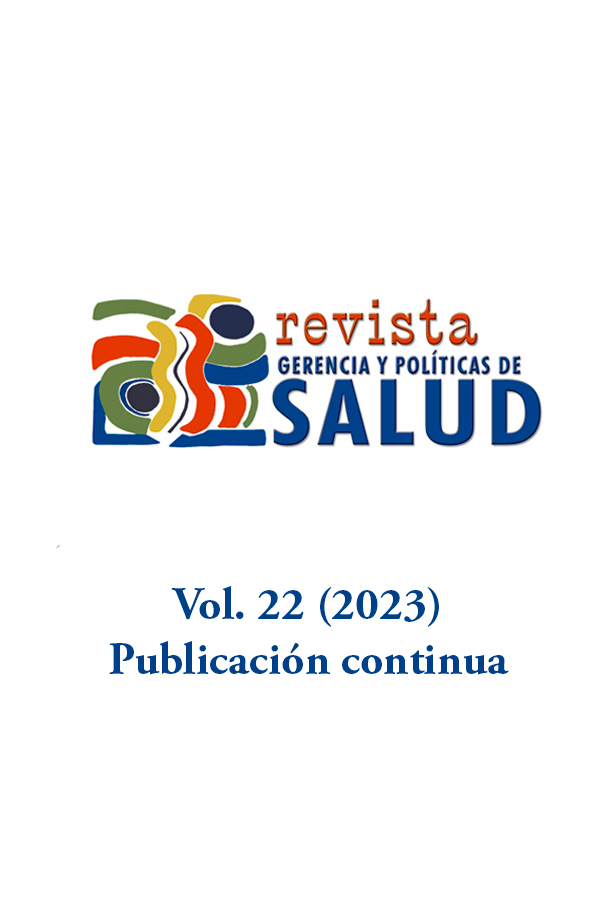Abstract
Objective: Evaluate the psychometric properties of the application of an instrument designed to measure the work environment for nursing care practice. Method: Methodological study of 4 phases: 1) Preparation and writing of items, 2) Face and content validity by experts, 3) Pilot test, 4) Construct validity and reliability. Results: ENLASA-Nursing is an instrument that consists of 59 items distributed in 2 parts (Part A: Dimension of organizational structural components and Part B: Dimension of organizational processes). The results obtained made it possible to classify each of the parts as satisfactory in terms of face and content validity; with satisfactory internal consistency and with an internal structure that allowed recognizing the conceptual elements of a healthy work environment that support its content. Conclusions: ENLASA-Nursing is a valid and reliable instrument, promising for research and evaluation of healthy work environments for clinical nurses in hospitals in Colombia.
Consejo Internacional de Enfermeras. Entornos de práctica favorables: lugares de trabajo de calidad=atención de calidad al paciente. Ginebra: CIE, 2007; p5. URL: https://docplayer.es/15042247-Entornos-de-practica-favorables-lugares-de-trabajo-de-calidad-atencion-de-calidad-al-paciente.html
Organización Internacional del Trabajo (OIT) (Plataforma de recursos de trabajo decente para el desarrollo sostenible). [Internet]. [cited 2023 Ago 04]. Available from: https://www.ilo.org/global/topics/dw4sd/themes/working-conditions/lang--es/index.htm
European Foundation for the Improvement of Living and Working Conditions (Eurofound). Condiciones de trabajo. [Internet]. [cited 2023 Ago 04]. Available from: https://www.eurofound.europa.eu/observatories/eurwork/industrial-relations-dictionary/working-conditions
Holly Wei, Kerry A. Sewell, Gina Woody, Mary Ann Rose, The state of the science of nurse work environments in the United States: A systematic review, International Journal of Nursing Sciences, Volume 5, Issue 3, 2018, Pages 287-300, ISSN 2352-0132, https://doi.org/10.1016/j.ijnss.2018.04.010.
Lake, Eileen T.; Sanders, Jordania;Duan, Rui; Riman, Kathryn; Schoenauer, Kathryn; Chen, Yong. A Meta-Analysis of the Associations Between the Nurse Work Environment in Hospitals and 4 Sets of Outcomes. Medical Care 57(5):p 353-361, 2019. DOI: https://10.1097/MLR.0000000000001109
Aiken LH, Patrician PA. Measuring organizational traits of hospitals: The revised nursing work index. Nurs Res. 2000;49(3):146–53. https://doi.org/10.1097/00006199-200005000-00006.
Lake ET. Development of the practice environment scale of the nursing work index. Res Nurs Heal. 2002;25(3):176–88. https://doi.org/10.1002/nur.10032
Kramer BM, Schmalenberg C, Maguire P. Essentials of a Magnetic work environment. Nursing 2008 Career Directory. 2008;23–7. URL: http://nursingcenter.hotims.com.
Beth Ulrich , Linda Cassidy , Connie Barden , Natasha Varn-Davis , Sarah A. Delgado; National Nurse Work Environments - October 2021: A Status Report. Enfermera de Crit Care 1 de octubre de 2022; 42 (5): 58–70. doi: https://doi.org/10.4037/ccn2022798
Huddleston P, Mancini ME, Gray J. Measuring Nurse Leaders’ and Direct Care Nurses’ Perceptions of a Healthy Work Environment in Acute Care Settings, Part 3. JONA J Nurs Adm [Internet]. 2017;47(3):140–6. https://doi.org/10.1097/NNA.0000000000000456
Choi J, Bakken S, Larson E, Stone PW. Perceived Nursing Work Environment of Critical Care Nurses. Nurs Res. 2004;53(6):370–8. https://doi.org/10.1097/00006199-200411000-00005
Yildirim D, Kisa S, Hisar F. Validity and reliability of the Turkish version of the Essentials of Magnetism Scale (EOM II). Int Nurs Rev. 2012;59(4):570–6. https://doi.org/10.1111/j.1466-7657.2012.01007.x.
Bai J, Hsu L, Zhang Q. Validation of the Essentials of Magnetism II in Chinese critical care settings. Nurs Crit Care. 2015;20(3):134–45. https://doi.org/10.1111/nicc.12041
De Brouwer BJM, Kaljouw MJ, Kramer M, Schmalenberg C, van Achterberg T. Measuring the nursing work environment: Translation and psychometric evaluation of the Essentials of Magnetism. Int Nurs Rev. 2014;61(1):99–108. https://doi.org/10.1111/inr.12073
Oshodi TO, Crockett R, Bruneau B, West E. The nursing work environment and quality of care: A cross-sectional study using the Essentials of Magnetism II Scale in England. J Clin Nurs. 2017 Sep;26(17–18):2721–34. https://doi.org/10.1111/jocn.13783.
Peña Alfaro BS. Desarrollo y validación del instrumento ENLASA-Enfermería para la evaluación de un entorno laboral saludable en el ámbito hospitalario [Internet]. Universidad Nacional de Colombia; 2021. Available from: https://repositorio.unal.edu.co/handle/unal/80839
Polit D, Beck C. Nursing research: generating and assessing evidence for nursing practice. Tenth edit. Wolters Kluwer., editor. Philadelphia: Lippincott Williams & Wilkins; 2017.
Peña Alfaro BS, Arango Bayer GL. Percepción de enfermeros colombianos sobre un entorno laboral saludable para la práctica asistencial en el ámbito hospitalario. Salud UIS. 2023; 55: e23014. doi: https://doi.org/10.18273/saluduis.55.e:23014
Donabedian A. An Introduction to Quality Assurance in Health Care. 1. New York: Oxford University Press; 2003.
Escurra M LM. Cuantificación de la validez de contenido por criterio de jueces. Rev Psicol. 1988;6(1–2):103–11. https://doi.org/10.18800/psico.198801-02.008
Pedrosa I, Suárez Álvarez J, García Cueto E. Evidencias sobre la Validez de Contenido: Avances Teóricos y Métodos para su Estimación. Acción psicológica. 2013;10(2):4–11. https://dx.doi.org/10.5944/ap.10.2.11820
Ruiz A, Gomez C. Epidemiología clínica, Investigación Clínica aplicada. 2da Edició. Panamericana E médica, editor. Bogotá - Colombia; 2015.
Tornimbeni S, Pérez E, Olaz F. Introducción a la psicometría. 1ra Edició. Buenos Aires: Editorial Paidos; 2008.
Norman G, Streiner D. Biostatistics. The bare essentials. Fourth Edi. PMPH-USA Ltd., editor. Vol. 53, Journal of Chemical Information and Modeling. Connecticut, USA; 2014.
Peña D. Análisis de datos multivariantes. McGraw-Hill Interamericana de España; 2002.
Pérez ER, Medrano L. Análisis Factorial Exploratorio: Bases Conceptuales y Metodológicas. Rev Argent Cienc Comport. 2010;2(1889):58–66. ISSN 1852-4206. URL: https://dialnet.unirioja.es/servlet/articulo?codigo=3161108
Wynendaele H, Willems R, Trybou J. Systematic review: Association between the patient–nurse ratio and nurse outcomes in acute care hospitals. J Nurs Manag. 2019;27(5):896–917. https://doi.org/10.1111/jonm.12764
Chiavenato I. Administración de recursos humanos. El capital humano de las organizaciones. Novena Edi. McGRAW-HILL/INTERAMERICANA EDITORES S.A., editor. México, D.F; 2011.
Toro Álvarez F. El clima organizacional. Perfil de Empresas Colombianas. 1ra Edició. Cincel LTDA, editor. Medellín - Colombia; 2001.
Kramer M, Maguire P, Schmalenberg C. Excellence Through Evidence: The What, When, and Where of Clinical Autonomy. J Nurs Adm [Internet]. 2006;36(10):479–91. https://doi.org/10.1097/00005110-200610000-00009
Kramer M, Schmalenberg C. Development and Evaluation of Essentials of Magnetism Tool. J Nurs Adm. 2004;34(7):365–78. https://doi.org/10.1097/00005110-200407000-00010
Kramer M, Schmalenberg C. Confirmation of a healthy work environment. Crit Care Nurse. 2008;28(2):56–63. PMID: 18378728. URL: http://ccn.aacnjournals.org
Connor AJ, Ziniel SI, Porter C, Doherty D, Moonan M, Dwyer P, et al. Interprofessional use and validation of the aacn healthy work environment assessment tool. AJCC Am J Crit Care. 2018;27(5):363–71. https://doi.org/10.4037/ajcc2018179

This work is licensed under a Creative Commons Attribution 4.0 International License.
Copyright (c) 2023 Bairon Steve Peña Alfaro, Gloria Lucia Arango Bayer


